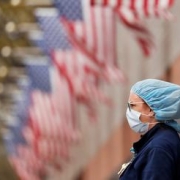The White House tapped former GlaxoSmithKline executive Moncef Slaoui to helm the administration’s “Operation Warp Speed” initiative, which has a goal of developing and distributing hundreds of millions of doses of a vaccine against COVID-19.
The U.S. death toll from the coronavirus outbreak could exceed 74,000 by August, according to the University of Washington’s predictive model, often cited by White House officials and state public health authorities.
How the pandemic changes the health policy outlook
April 2020, Commissioner, Coronavirus Cases, Coronavirus Disease (COVID-19) Pandemic, Department of Health and Human Services (HHS), Donald Trump, Drug Price Legislation, Elections, FDA, FDA/Regulatory, Issue Archives, Jon Bigelow Column, Med Ad News, Senate, United States Department of Homeland Security, White HouseThis extraordinary March and April – marked by rising numbers of Covid-19 cases and fatalities, suffering for patients and families, courageous efforts by clinicians, restricted social interaction, business closings, massive unemployment – has battered our healthcare system and economy. Here are a few early thoughts on how the evolving pandemic has changed the outlook for health policy after the November elections.
Next wave of U.S. states set to reopen as coronavirus could push jobless rate to 16%
Alaska, Andrew Cuomo (NY), Arkansas, Colorado, Congressional Budget Office, Coronavirus Disease (COVID-19) Pandemic, Coronavirus Disease 2019 (COVID-19), Economy, Georgia, Iowa, Jobless Rates, Medical Experts, Minnesota, Mississippi, Montana, Nebraska, New York, North Dakota, Oklahoma, Opinion Polls, Public Health Crisis, South Carolina, South Dakota, Tennessee, Utah, White House, WyomingAnother wave of states prepared to ease coronavirus restrictions on U.S. commerce this week, despite health experts warning there is still too little diagnostic testing, while the White House forecast a staggering jump in the nation’s monthly jobless rate.
Better-than-expected social distancing practices have led an influential research model to lower the projected U.S. coronavirus death toll by 12 percent, while predicting some states may be able to safely begin easing restrictions as early as May 4.
U.S. Vice President Mike Pence promised that Americans would have access in the days ahead to more than 2,000 laboratories capable of processing coronavirus tests, and a leading expert said the country would launch a new phase of testing for the fast-spreading disease.
U.S. President Donald Trump will meet with Treasury Secretary Steven Mnuchin and other economic officials to weigh possible actions to stem the fallout from a widening coronavirus outbreak, an administration official told Reuters.
While fears of a potential coronavirus or flu pandemic continue to grow across the globe, the White House is calling for a 16% cut to the budget of the U.S. Centers for Disease Control (CDC), as well as a 10% cut to the Department of Health and Human Services.
Chants of “H.R. 3” broke out in the House of Representatives chamber during the 2020 State of the Union Address as Democratic lawmakers urged action on the bill passed late last year that could impact the price of prescription medications paid for by government-funded health programs.
Prescription drug prices dropped 1 percent in 2018 – the first time such a drop has occurred in the United States in 45 years – driven primarily by a greater reliance on generic drugs and much slower increases in branded drugs, according to a government study.





